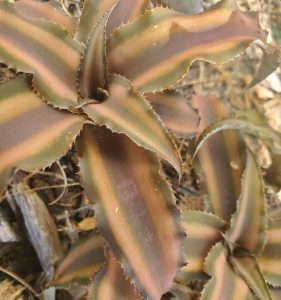
You may have seen one of these plants before, or maybe even had one of your own. These small terrestrial bromeliads are often used in terrariums, dish gardens or even outside as a groundcover. Know best for their brilliantly colored striped foliage, the Cryptanthus or earth star is a unique and welcome addition to your plant collection. I had one many years ago, and now I have a small pot of them once again!
Earth stars are only about five to six inches in size with somewhat wavy serrated edged leaves which form a star-like rosette. Each leave is stripped with variegated bands of color oriented long way or across the leaf depending on the species. It is reported that over one-thousand a, two-hundred species of Cryptanthus exist so their colors and pattern manifestations can vary. They flower only once producing a small cluster of whitish blossoms in the center of the rosette of this plant. Like other bromeliads, once the plant flowers, it perishes but not before producing a series of side shoots suitable for propagation. Use a sterile potting medium and press offshoots into the soil. Remember that earth stars are not “air plants” and do require a soil medium into which to root and grow.
Proper lighting is important for retaining the rich color without scorching the leaves from too much sun. As earth stars are originally from Brazil where they thrive in bright indirect sun on forest floors, provide morning and evening sun exposure for best results. Unlike their other bromeliad relatives, earth stars do not have that central cup of leaves (tank) that holds water. Earth stars like to be watered only when the soil is dry to the touch but do like humidity that might be found in a terrarium.
While the earth stars commonly available are often pink and green stripped, there are a number of named varieties to search for including the cultivars ‘Black Mystic’ – with dark green-black leaves and cream-colored banding, ‘Zebrinus’ with zigzag cream bands on dark leaves, and ‘Rainbow Star’ – with dark green leaves sporting bright pink edges and zigzag creamy banding.
Earth stars are plants with simple demands that are colorful year-round and fit into a number of home gardening settings. I have seen them on occasion at local garden centers often included amongst other houseplants or within small terrariums. Many varieties are available from mail order on-line gardening websites to widen your selection options.
Earth stars satisfy the gardener’s need for color, easy care, and eye-appeal. When you find one, you will know what I am talking about – you will be earth star struck! For more information on all types of unique plants to grow in Southwest Florida, or to ask a question, you can also call the Master Gardener Volunteer Helpdesk on Mondays, Wednesdays, and Fridays from 1 to 4 pm at 764-4340 for gardening help and insight into their role as an Extension volunteer. Ralph E. Mitchell is the Director/Horticulture Agent for UF/IFAS Extension – Charlotte County. He can be reached at 941-764-4344 or ralph.mitchell@charlottecountyfl.gov. Connect with us on social media. Like us on Facebook @CharlotteCountyExtension and follow us on Instagram @ifascharco.
Resources:
Cryptanthus zonatus (2024) North Carolina Extension Gardener Plant Toolbox. NC State University.
Green earth star Cryptanthus bivittatus. (2024) North Carolina Extension Gardener Plant Toolbox. NC State University.
Earth Star Bromeliad Cryptanthus bivittatus. (2024) North Carolina Extension Gardener Plant Toolbox. NC State University.
Clemson Cooperative Extension Home and Garden Information Center.
Miller, L. (2021) Cryptanthus Earth Star – How To Grow Cryptanthus Plant. Gardening Know-How.
Smith, B. H. (2019) (Earth Star (Cryptanthus bivittatus) The National Gardening Association – Plants Database.
 1
1
